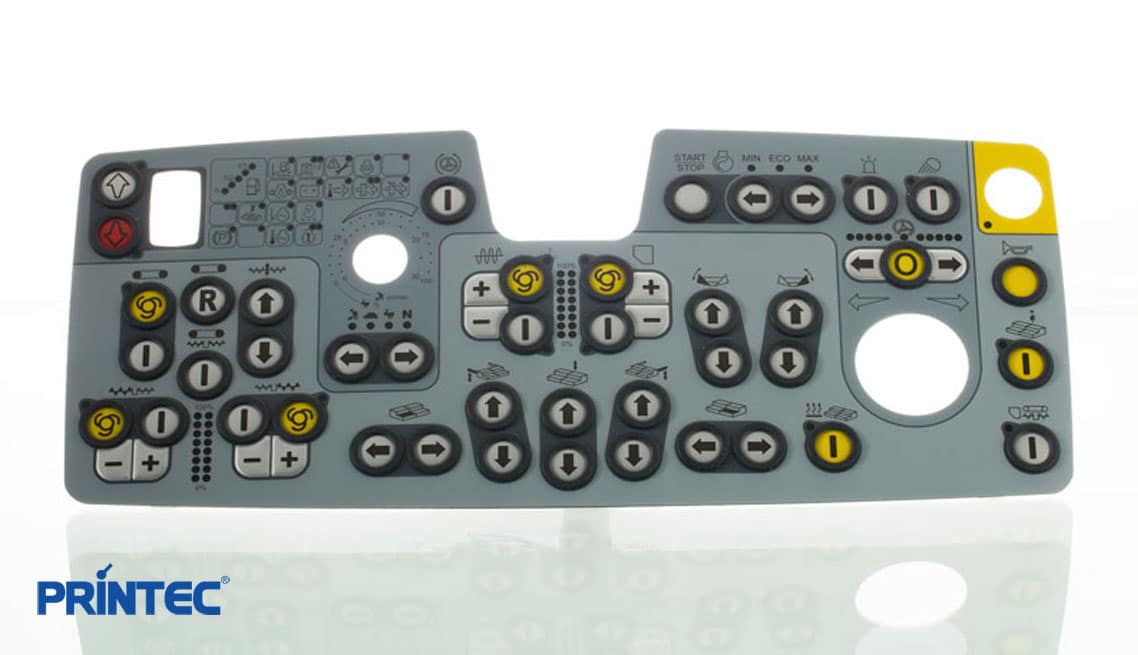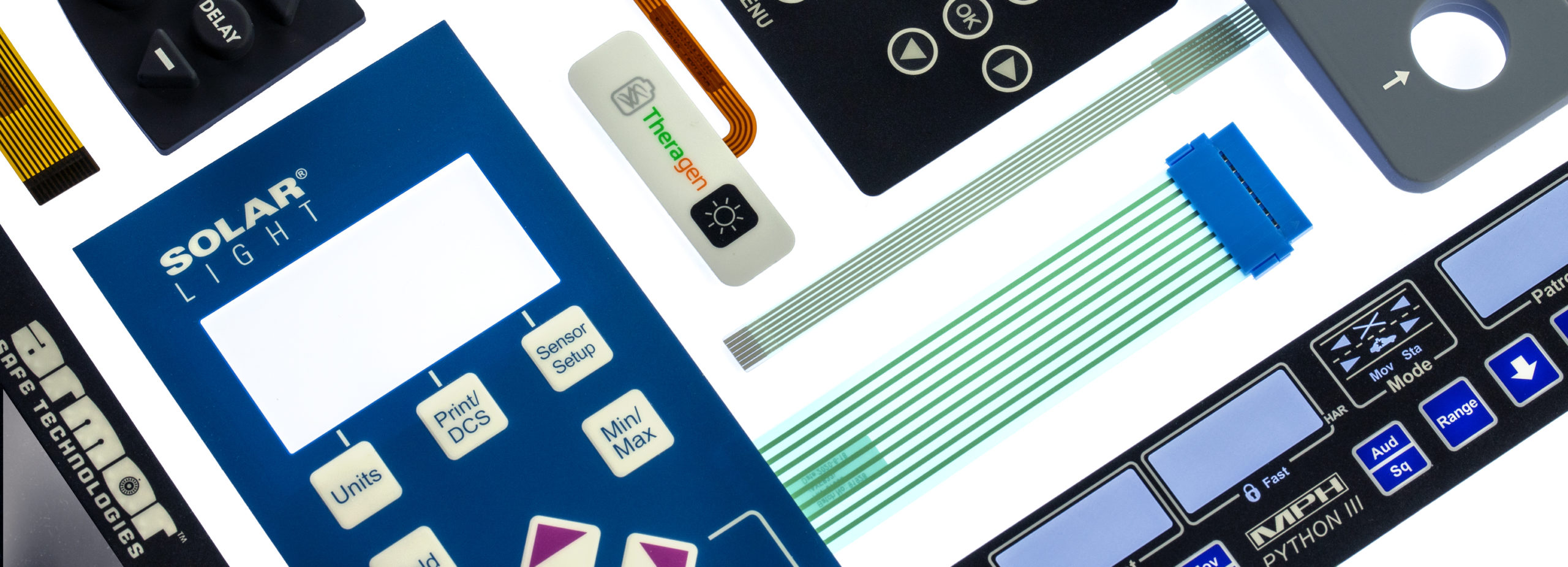Projects requiring accuracy should always involve a qualified membrane switch manufacturer from the start.
Projects requiring accuracy should always involve a qualified membrane switch manufacturer from the start.
Blog Article
All Regarding Membrane Change: Comprehending Its Layout and Functionality
When you think of the control user interfaces in modern-day devices, membrane layer buttons often enter your mind. These elements are greater than just buttons; they mix design and capability seamlessly. Recognizing exactly how they function and what makes them effective can alter your perspective on day-to-day electronic devices. There are nuances to their style and efficiency that you could not be conscious of. Allow's explore what collections membrane layer changes apart from other control systems.
What Are Membrane Layer Buttons?

Their smooth nature makes them easy to clean and immune to dust and dampness, a vital feature in lots of settings. Membrane layer switches can also be tailored pertaining to shape, size, and graphics, permitting manufacturers to produce one-of-a-kind interfaces customized to details products. Plus, they're light-weight and slim, which aids in decreasing the overall bulk of devices. Generally, membrane layer buttons play a significant function in enhancing user experience across a broad variety of applications.
Just How Membrane Switches Over Work
When you push a trick on a membrane button, it activates an uncomplicated yet efficient system. membrane switch manufacturer. The leading layer, frequently made of versatile product, pushes down onto a conductive layer below it.
You'll observe that the responsive comments differs based on the button design, using either a soft click or a much more pronounced feedback. Once you release the trick, the membrane returns to its initial setting, reopening the circuit and stopping the signal. This procedure takes place practically instantly, ensuring a receptive customer experience.
Membrane switches are prominent as a result of their resilience and resistance to dirt and moisture, making them suitable for various applications, from family devices to clinical gadgets. Understanding this procedure helps you appreciate their widespread use.
Trick Components of Membrane Layer Buttons
Understanding the crucial parts of membrane layer buttons is fundamental for realizing their functionality and design. At the core, you'll find the graphic overlay, which offers the visual interface for individuals. Underneath that, there's a spacer layer that divides the circuit layers, making sure that they do not make contact until pushed. The circuit layer is where the magic takes place; it is composed of conductive traces that finish the circuit when you push the switch. An additional important element is the glue backing, allowing the button to follow surfaces firmly. The safety layer guards versus ecological elements and wear, extending the button's life-span. Each element plays a considerable duty in making certain dependable efficiency and customer interaction. By understanding these components, you'll get understanding right into just how membrane changes operate and their significance in various applications.
Products Used in Membrane Switch Style
The efficiency and longevity of membrane switches over heavily depend upon the materials utilized in their design. You typically come across polyester and polycarbonate as primary substratums as a result of their exceptional toughness and adaptability. These products resist scrapes and chemicals, making them suitable for requiring atmospheres.
The conductive layers frequently use silver or carbon, picked for their reliability and conductivity. membrane switch manufacturer. Silver gives superior performance, while carbon is a cost-effective option. For the overlay, you may consider a matte or shiny coating, depending on your aesthetic needs and user experience
Adhesives play a crucial role as well; they bond layers securely and guarantee durability. Make sure to pick adhesives that withstand environmental elements like temperature level and moisture. Don't ignore the relevance of an excellent printing strategy for graphics, as it boosts both functionality and visual appeal. Choosing the right materials will guarantee your membrane button stands the examination of time.
Style Factors To Consider for Membrane Layer Buttons
While designing membrane layer switches, it's essential to take into consideration various factors that affect their performance and individual experience. Start by focusing on the design and button dimension; ensure they're instinctive and simple to navigate. Think about the tactile responses you intend to offer-- will individuals need a visible click or a softer touch? Additionally, consider the products you'll use, as they'll impact longevity and aesthetic appeals.
Do not neglect the graphic style; clear labeling and shade contrast are considerable for visibility. Validate your design fits ecological variables, like wetness or temperature variants, which could influence performance. Ultimately, remember the value of screening models with genuine users to gather comments and make needed changes. This iterative procedure assists you improve the style, confirming it meets both functional Read Full Article and visual demands effectively. By carefully considering these components, you'll produce a membrane button that boosts usability and contentment.
Applications of Membrane Buttons
Membrane switches are versatile parts located in various applications, from industrial devices to consumer electronic devices. You'll see their influence in makers that need resilient interfaces and in tools that profit from sleek designs. Understanding these applications aids you value the functionality and practicality of membrane layer buttons in everyday modern technology.
Industrial Tools Use
When you're looking to boost the capability of industrial tools, membrane switches supply a reliable solution that integrates resilience with straightforward design. These switches are excellent for extreme environments, giving resistance to dust, wetness, and chemicals. You'll find them in control panels for manufacturing machines, cooling and heating systems, and clinical gadgets, where accuracy and responsiveness are crucial. Their reduced account means they fit perfectly right into different tools, saving valuable area while keeping simplicity of usage. With customizable graphics and backlighting choices, you can develop an user-friendly user interface for drivers, improving efficiency and security. And also, their lengthy life-span minimizes upkeep costs, making them a wise financial investment for your commercial applications. Embrace membrane buttons to streamline your operations and enhance overall performance.
Customer Electronic Devices Integration
In the domain of customer electronics, membrane layer switches play a vital function in enhancing customer interaction and device capability. Membrane buttons likewise assure toughness and resistance to dust and dampness, prolonging the life-span of your electronics. By choosing membrane buttons, you boost not just the functionality but additionally the style of your gadgets, making everyday interactions smooth and enjoyable.
Advantages and Disadvantages of Membrane Buttons
While membrane switches supply an array of benefits, they likewise feature some disadvantages that you should take into consideration. One substantial advantage is their small layout, making them optimal for space-constrained applications. They're likewise cost-effective, supplying a sturdy option with a reduced production expense. Additionally, their seamless surface is simple to tidy, improving hygiene in settings like healthcare facilities.

Membrane layer switches can have a much shorter life expectancy compared to mechanical buttons, especially under hefty use. They can also be much less tactile, which could affect customer comments throughout procedure. Balancing these pros and disadvantages will aid you establish if membrane layer buttons are the appropriate fit for your project.
Regularly Asked Questions
How Much Time Do Membrane Layer Changes Usually Last?
Membrane layer switches usually last between 5 to one decade, depending upon usage and environmental problems. You'll want to review aspects browse around this web-site like wear, exposure to dampness, and temperature changes to gauge their long life successfully.
Can Membrane Changes Be Custom-made for Particular Layouts?
Yes, you can tailor membrane layer switches to fit particular designs (membrane switch manufacturer). You'll have the liberty to choose shades, forms, and layouts that match your job's demands, ensuring they mix seamlessly with your overall visual
What Is the Cost Array for Membrane Change Manufacturing?
The expense variety for membrane layer button production commonly falls between $1 and $10 each, depending on aspects like style intricacy, amount, and materials. You can get quotes from manufacturers to discover the ideal option.

Are Membrane Changes Water-proof or Immune?
Membrane switches can be made to be water-proof or resistant, depending on materials made use of and construction techniques. If you need them for wet environments, ensure you specify those demands during the design process.
How Do Membrane Switches Compare to Standard Switches?
Membrane layer switches are normally thinner and extra adaptable than standard buttons, providing a smooth design. They're commonly easier to clean and incorporate, but may not give the responsive comments you're made here are the findings use of to with mechanical options.
Final thought

Report this page